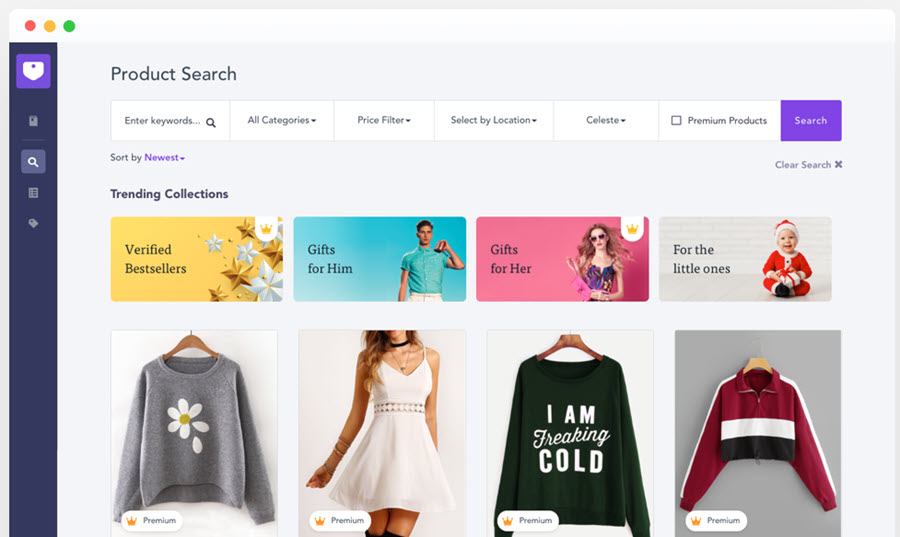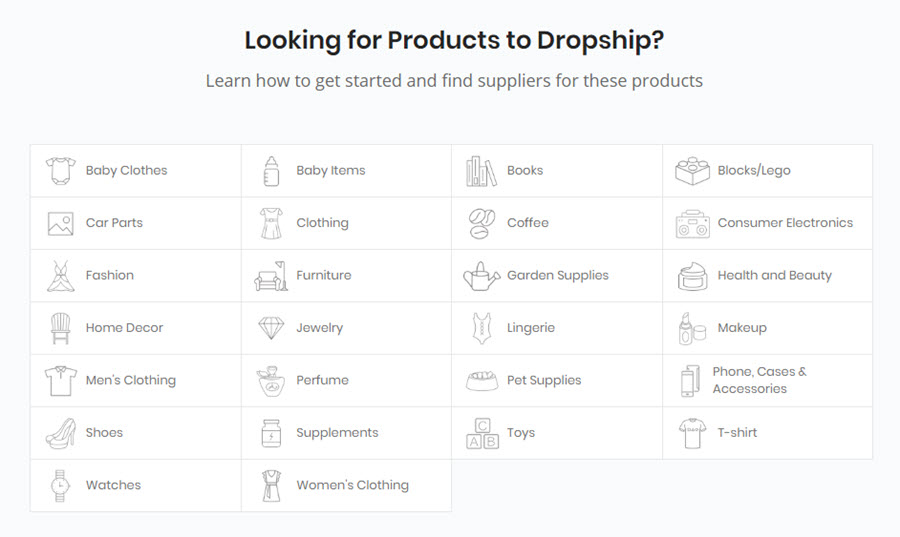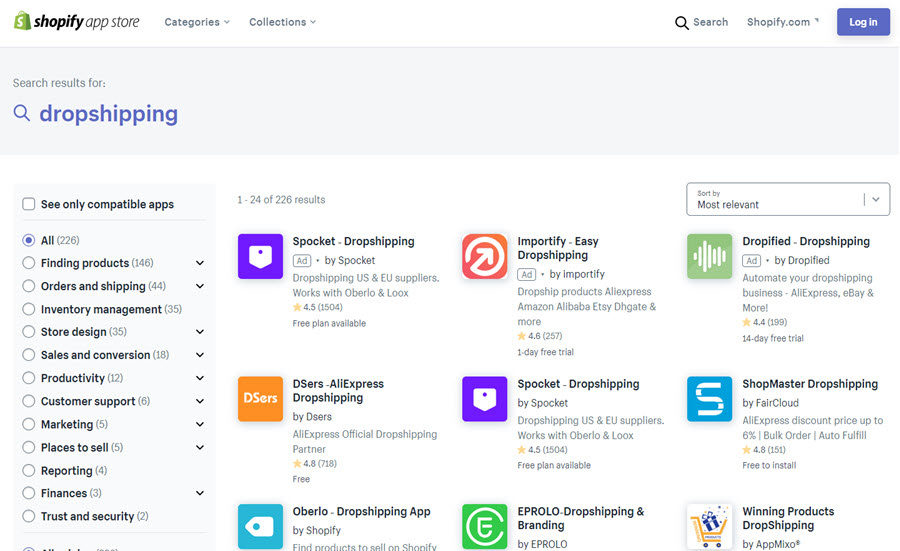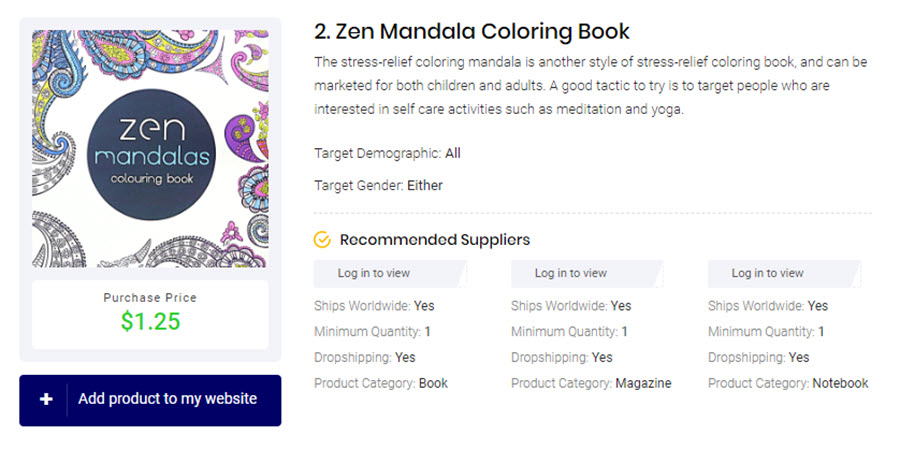What Exactly is Dropshipping?
Dropshipping is a form of online retail selling where the retailer doesn't have to pay for the products before selling them to customers.
Dropshipping serves as a type of third-party fulfillment method to keep prices extremely low for retailers, where the suppliers or manufacturers are the ones storing, packaging, and shipping the products, removing that burden from the retailers.
Overall, selling online, and from a brick-and-mortar store, usually requires a supplier, a retailer (the store the customers buy from,) and a customer.
Online retailers need to find some sort of supplier in order to either manufacture their proprietary products or to acquire other items at wholesale cost. Then, the retailer needs to store, package, and ship those products when a sale is made.
Over the years, third-party fulfillment has emerged as a more economical way to store, package, and ship. Instead of the retailer paying for a warehouse, or storing items in their homes, why not give the inventory to a separate company to handle that?
Several third-party shipping models are available. Many people take advantage of Amazon Fulfillment if they sell on Amazon. Other fulfillment brands include ShipBob, Red Stag Fulfillment, and ShipMonk. In general, they all provide great rates to fulfill orders.
Dropshipping, is another form of third-party fulfillment. In short, the supplier never sends the products to the retailer to then decide if they'd like to store the inventory elsewhere. Instead, the suppliers hold onto the inventory and ship out orders as they come in.

Free Webinar: How to Quickly Start a Profitable Dropshipping Store
Learn how to find high-margin products, import them into your store, and start selling — fast.
How Does a Dropshipping System Usually Function?
Dropshipping is one of the simplest forms of fulfillment, since minimal shipping is required, it's cheap for online retailers, and you don't have to spend much time worrying about packaging or inventory management.
Dropshipping works like this:
- An online retailer finds a supplier willing to start dropshipping.
- The retailer lists available products on their ecommerce store, spending most of their time and money marketing.
- When a customer places an order, the supplier gets a notification to fulfill that order.
- The supplier pulls the inventory from storage, packages it, and ships it directly to the customer.
The primary basis behind dropshipping is that the inventory never touches the hands of the actual online retailer.
You, the retailer, pick products from the supplier's inventory. You display the products on your website to sell. They handle the rest.

Most dropshippers handle returns, but some dropshipping suppliers make things easy by accepting returns to their warehouses as well.
In general, the retailer doesn't have to worry about storage, packaging, or shipping costs. Not to mention, there's no need to hire people to do these tasks or spend their own time managing a large operation.
Obviously, there are pros and cons to dropshipping. Also, as a newer form of fulfillment, the internet is filled with scams and fake case studies to get hopes up about making lots of money.
Dropshipping does in fact work for some businesses. It's a fascinating ecommerce business model that cuts out many of the costs of doing business. After all, the supplier already has the warehouse and the packaging supplies, why not send out the products as well?
The Difference Between Dropshipping and Affiliate Marketing
You may think that a dropshipping site is the same as affiliate marketing. For both, products aren't being managed by the site owner. Instead, the site owner is acting as more of a middleman between the customer and the supplier.
However, there are some distinct differences:
- Dropshipping requires you to partner with a supplier or manufacturer.
- Affiliate marketing can be done by signing up for any retailer's affiliate program.
Regarding the setup:
- Dropshipping typically involves the retailer making and managing an online store. It functions just like a real ecommerce store.
- Affiliate marketers only need links to quality products that they might recommend. There's no need to have an online store with shopping cart functionality. In fact, many affiliate marketers opt for blogs instead of online stores.
Differences in costs:
- Although inexpensive, dropshipping often requires a complete online store, heavy marketing, and research costs.
- Affiliate marketers don't have many costs, besides starting a website. There's no fee to join an affiliate program. They may spend some time with research and marketing, but much of the traffic brought in is organic.
Control and processes:
- Dropshippers still have control over some of the processes. They're also taking risks and are seen as an essential part of the sales pipeline.
- Affiliate marketers are removed from the production process completely. They're referrers. They get a commission once a referral is made. After that, the actual retailer takes over.
Returns and customer support:
- Dropshippers often handle returns. It's also a good idea to have some sort of customer service through chat, email, and even through the phone.
- Affiliate marketing doesn't require you to accept returns, ever. You don't carry, own, or touch the products. You're referring customers to another company. There's also no need for customer service. It's rather common that the company you refer business to doesn't even know you exist.
Is Dropshipping Legal?
Yup. Dropshipping is in no way a shady business practice. It's simply a new way of thinking about fulfillment. That's why we want to teach you how to make money dropshipping the right way, without anything shady.
Are there fishy things going on in the industry? Absolutely. It's similar to some of the repercussions we see with cryptocurrency. The knowledge isn't being communicated properly, so uninformed people get taken advantage of.
Some examples of this include pricey training seminars and courses promising riches from dropshipping. You can find plenty of YouTube videos and case studies about dropshipping successes. The only problem is that numbers are often made up or not entirely true.
Therefore, yes, dropshipping is legal. It's possible to make some decent money if you work hard and locate the right products and suppliers. But as with all new ideas, people are taking advantage of the lack of knowledge in the industry.
My best advice is to avoid spending any money on dropshipping courses. And don't get too excited when a random blog post talks about a person making loads of money from dropshipping.
People often forget that you can typically learn everything you need to know about a topic for free online. It can take some digging, but that's good practice for product research in the future.
Can You Make Money Online With Dropshipping?
Can you make money selling cars or diamonds or books or tables or clothing? Yes to all of those.
You can make money selling just about anything in this world, it just depends on your dedication and approach.
With dropshipping, the margins are low. The overhead costs are low. The shipping, packaging, and storage costs are often close to nothing. The marketing costs are higher. You also may find it difficult to sell anything if you don't choose the right product.
This is kind of a silly question, since there aren't any studies out there that tell us the exact percentage of dropshipping businesses that survive or fail. Just like we don't know the exact percentage of shoe companies that survive or fail.
The same can be said for profitability. Unless your company is public, we don't have information about how much money you can make with anything. All we know is that if you have a unique enough idea, and you spend lots of effort supporting that idea, you may have a chance at making some good money.
Dropshipping is no different than starting any other business. There are opportunities. There are bad ideas. There are great ideas. Luck is also a heavy factor, even though every successful businessman tries so hard to state otherwise.
What Are The Costs?
When learning how to make money dropshipping, it's prudent to figure out the costs beforehand. Otherwise, you may find that you can't afford to get into the business in the first place.
I'll begin with a general breakdown of how the costs look for dropshipping, then analyze the specific costs to give you a better idea of what to expect.
- Building a website – Similar costs to other online businesses.
- Payment processing – Similar costs to other online businesses.
- Marketing – More costly than usual.
- Sourcing – Normal, or less costly than usual.
- Storage – Significantly less costly than usual.
- Packaging – Significantly less costly than usual.
- Shipping – Significantly less costly than usual.
- Returns and chargebacks – Normal when handled properly. However, returns and chargebacks could easily put a dropshipping operation out of business. The average dropshipper will most likely see higher return rates since the quality control is lower.
- Customer service – Normal.
Obviously, there are other costs of doing business, but those are the main ones.
Next, let's consider the actual pricing ranges for our categories.
- Building a website – Websites range drastically in price, but a startup should spend around $30 per month for an online store. This could come in the form of a Shopify store, BigCommerce, WooCommerce, or one of the many other platforms. If you're making a serious business, don't opt for a free website.
- Payment processing – The processing fees are going to be the same as usual for dropshippers. Expect the standard of 2.9% +$0.30 per transaction.
- Marketing – Most dropshipping expenses involve marketing. From Facebook Ads to Google Ads, and email marketing to loyalty programs, you need to grab attention to sell products. It's tough to say, but anywhere from $100 to several thousand per month sounds realistic. You may start with $10 or $20 per week on Facebook Ads, but eventually, the marketing costs will grow.
- Sourcing – Sometimes you don't have to pay anything to find a high-quality dropshipper. Some of the top platforms charge monthly, from $30 to $100 per month.
- Storage – You should technically spend $0 in this category, but returns could ruin that.
- Packaging – Packaging should also float around $0.
- Shipping – You'll still have to pay for shipping, but many dropshipping platforms negotiate great rates.
- Returns and chargebacks – A return is rough on a dropshipping operation. You end up refunding the money, then the product often comes back to your home, not to the supplier. Then, you have to either eat that cost or use the item to ship out in the future. In addition, a credit card chargeback costs around $30 per chargeback, making it very important to avoid these.
- Customer service – I can't estimate a cost for your customer service. However, don't skimp on customer service offerings, seeing as how you really want to avoid chargebacks. You can recover from a returned item, but chargebacks will kill any dropshipping business.
Is Dropshipping Worth It?
Learning how to make money with dropshipping is one thing. But, it's not going to turn your business into a successful one overnight.
The content online for dropshipping is cluttered with misinformation. The deals for dropshipping tools are often far too expensive, and the margins for products are absolutely terrible.
Nevertheless, dropshipping has potential, for some businesses. It's possible to make a quality dropshipping store from scratch. It's also sometimes even a better idea for existing businesses to move some of their products to the dropshipping model.
It's impossible to surmise the exact recipe of a successful and unsuccessful dropshipping store, but we can at least put together some key elements.
The Elements of a Successful Dropshipping Store
- A successful dropshipping store keeps costs extremely low, especially in the beginning. This means learning about the business yourself and not spending money on costly classes. Don't spend much on sourcing, find economical ecommerce platforms, and use yourself as the customer support.
- Still, you don't want to be cheap. The website should look beautiful. It's far too easy for people to identify a dropshipping site when a professional hasn't designed it. In addition, don't just go to AliExpress and find products with the cheapest costs. They're often bad products and bound to be returned. Also, AliExpress isn't all that great for most dropshippers.
- The product descriptions, and website content, should be repurposed and professionally written.
- A quality dropshipper researches the market on a regular basis. Sign up for notifications about the hottest retail products. Make friends in ecommerce. Learn about trends that are making other stores money. Is there a new product that might sell well on your site?
- A successful dropshipping store partners with a fast and efficient supplier. This means a maximum of five-day shipping. You typically need a supplier in your country to make this happen.
- The products can't be priced much higher than the competition.
- Great dropshippers usually talk to their suppliers to get their own store branding on, or inside, the packaging.
- You should have several marketing tools configured, from social media to email marketing, and rewards to an affiliate program.
- The best dropshippers have incredible customer support. They hire professionals.
- All top-notch dropshippers actually spend some money on samples to understand what they're selling.
The Elements of a Bad Dropshipping Store
- The website looks like it was made by an amateur, potentially right from a Shopify theme without any customizations. Hint: Free Shopify themes are usually junk when not customized by a professional developer.
- The product pages are filled with poor photos, product descriptions, and product names pulled from the supplier. You must find someone to rewrite all manufacturer copy.
- Don't order samples. This is a fast track to bad product photos and low-quality control. Who knows what you're selling to people?
- You don't have a budget for heavy marketing. The best way to make money through dropshipping is to learn about how to target properly on Google and Facebook Ads. Too much money is wasted by people who don't know how to optimize online ads.
- Bad customer support. If you're a nice, patient person, maybe you can run your own customer support. Unfortunately, if you're snarky, unresponsive, or mean, that's only going to lead to returns and chargebacks, destroying your dropshipping business.
- Offer slow shipping. No one wants to wait more than a week to get their product, even if it was cheap.
- Going right to AliExpress. The AliExpress dropshipping model has its place, but most companies outside of China will find that the products are no good, the shipping can take up to a month to deliver, and the quality control is the worst in the business. Oh yeah, and you better know Chinese to speak with your supplier.
- You sell products that can easily be compared and found for a lower price on Google. Some products are too easy to find for cheaper. Your margins are already low with dropshipping, so it's best to find a unique niche and products that are less “comparable,” like decorations or art.

How to Make Money Dropshipping: The Pros and Cons of Dropshipping
The pros and cons of dropshipping are in fact different than the elements of a good and bad dropshipping store. The pros and cons detail the benefits and downsides of the fulfillment model for you as a vendor. It's not difficult to learn how to make money dropshipping. The key is to understand the pros and cons and prepare for them.
Pros 👍
- Dropshipping allows for greater flexibility when running your business. It cuts out many elements like shipping, packaging, and storage. Therefore, you can spend time and money on other aspects of your business like research and marketing.
- There are loads of products to choose from when dropshipping. If you go to Amazon, every one of those products can be dropshipped.
- The startup costs are low, seeing as how you only have to pay for a website, advertising, and to partner with a dropshipping supplier.
- The risks are much lower, seeing as how you can pivot to a new product at any time, you're not investing thousands of dollars in inventory, and there's no need to sign any contracts with suppliers.
- The products cost less for you, since there's no need for storage and delivery.
- You often receive better shipping rates since the suppliers tend to land great contracts with companies like UPS and FedEx.
- The logistics are incredibly easy to handle. You link your website to the order management platform of your supplier. After that, they handle everything from packaging to shipping.
- Dropshipping gives you a chance to focus much of your time on quality customer care, since it's definitely needed in the dropshipping business.
- Dropshipping is allowed on other platforms like eBay and Amazon, expanding your market reach to other spots on the internet.
Cons 👎
- It's tough to build a brand. Your logo probably isn't getting placed on the boxes. Chances are you have no control over the marketing content being placed in the box. In short, the credit for your work is going to someone else most of the time. It's possible you could find a dropshipper who puts a piece of paper in each box for you.
- You may encounter bad suppliers. Whether they're doing something illegal or they're bad at hitting deadlines, you really have to do your research when looking at suppliers.
- You have virtually no control over the products and supply chain. Would you like to speed up deliveries? Would you like to check on product quality? Would you like to make sure products are boxed up properly? You usually have no control over this with dropshipping.
- Dropshipping is competitive because you're competing with non-dropshippers as well. Low overhead is nice, but that means that everyone is trying out dropshipping. Not only that, but the big retailers are still there, selling similar items for cheaper, with better brand recognition, faster shipping, and incredible return policies.
- The profit margins are insanely low. Again, the low overhead is a great reason to get into dropshipping. A broke college student has the means to start a dropshipping business. However, once you sell some items, you may cringe at how little you receive. Because the suppliers are handling most of the logistics, you only get a small cut of the pie. In addition, you have to factor in per-unit costs for ads, marketing, and site management.
We all want to learn how to make money dropshipping. Just because there are downsides doesn't mean you can't do it. The best business people take these cons and use them to their advantage or at least prepare for them.
How to Make Money Dropshipping: Starting Your Business
Researching and finding the right products is mainly up to you. In fact, that's what sets most great dropshipping businesses apart from the ones that fail. We can't teach you how to put in the work and research to find high performing products. We could recommend using Amazon, SaleHoo, Google Trends, and a myriad of other tools for your research, but it's more about how you use those tools.
However, we can give you the types of elements that you need to build your website and launch your dropshipping logistics plan.
Which Platforms are Required?
Dropshipping is no different from other online businesses, in that you still need an ecommerce platform and a way to connect with suppliers.
As the dropshipping industry has evolved, we've started to see apps emerge that automatically pair you with suppliers and link you to their inventory. This is a huge help.
As for the overall configuration for your operation, here's what we recommend:
An Ecommerce Platform

Shopify, BigCommerce, Volusion, and WooCommerce all work wonders when it comes to building your own online store for a small price per month.
WordPress and WooCommerce are free, but you'll need hosting, which comes out at the same price for a full ecommerce platform like Shopify.
We typically recommend Shopify for dropshipping, since it has a large collection of Shopify dropshipping apps to connect you with suppliers. It's also pretty easy to set up your own website.
Check out other ecommerce platforms that do the trick for dropshipping.
An App for Dropshipping

Shopify, BigCommerce, Volusion, WordPress, and many other platforms have app stores.
Several apps are available for pairing you with suppliers, choosing products, then syncing the product details with your store. You'll still want to get your own product photos and rewrite the descriptions, but it's a great place to start and cut down on some of the work.
Furthermore, the dropshipping apps notify the suppliers when you make a sale, allowing them to send out the shipments to the customers.
Here are some of the more popular dropshipping apps:
Hundreds of them exist. We recommend looking through the app stores and testing them all to figure out the following:
- Do they supply the products you want to sell?
- Are the shipping times reasonable?
- Are the suppliers inside or near your country?
- Are the margins reasonable?
- Do they provide product images and descriptions?
- Is there a cost to join?
- Do you get reviews on the suppliers and potential sales data?
A word of warning: Many of these apps simply link you to a service called AliExpress. It's owned by Alibaba, a Chinese online marketplace, similar to Amazon.
AliExpress definitely has a place in the market if you're selling extremely unique items or if you're shipping to countries close to China. Otherwise, many of the products are so cheap that you're only prepping yourself for a customer service nightmare. Also, your customers don't want to wait three to four weeks to get their item from China.
Finally, I've read many user experiences about how customers get really confused when they see Chinese or Vietnamese lettering on their packaging. Remember, your customers think they're purchasing from your store. They're used to buying from Amazon, or Nike, or Patagonia. None of those companies ship with Chinese return addresses and Chinese lettering on the packaging.
Luckily, many of the app developers are realizing this pitfall of dropshipping from China. Spocket and Oberlo have offerings for local suppliers.
An Advertising Account

Dropshippers, especially new ones, don't have any brand recognition. Therefore, you need to reel in customers with social and search engine advertising.
Start an account on Facebook Ads and learn about the best ways to sell on Google. All social and SEO ad platforms have their best practices. For instance, many people think that it's best to have one ad running on Facebook for a product. Research shows that one product may sell much better if you run ten slightly different ads targeted to separate groups of people.
Overall, targeting is key, along with wise usage of your money.
Marketing and Customer Support Apps: How to Make Money Dropshipping

Besides making sure your hotheaded CEO isn't speaking to customers, it's important to have a customer support system in place for fielding customer complaints and questions.
A good start is with the following types of apps:
- A live chat app for answering quick questions about your products.
- An email support system that gives customers a way to send more detailed questions.
- A solid return policy so that your customers don't get frustrated with some tedious process.
- A knowledgebase with FAQs and information about how your business operates.
How to Make Money Dropshipping by Finding the Right Suppliers
This question used to be more relevant when dropshipping apps didn't exist.
Now we have apps and dropshipping directories to locate the best dropshippers in your area.
And that's the key when finding your suppliers: Location is everything.
Dropshippers in the US should never ship from China. The same can be said for pretty much every retailer from a country far away from China. The shipping takes way too long, and you have no control over the product. In addition, the margins are so low that you won't have any extra money to spend on customer support when angry customers wonder why their product came from China and not your company.

So, find an app that has suppliers in your country, or a country nearby. It's ideal to find suppliers that at least speak your language and are going to print in that same language on packaging.
How to Make Money Dropshipping: Choosing the Best Suppliers
- Begin by searching for dropshipping apps from your ecommerce platform's app store. Google works for this as well.
- Install the app or start a free trial. Check to see if there are any suppliers with quick shipping times to your country.
- Are you willing to sell the types of products from that supplier?
- How do the margins look? Can you quickly go on Google to find similar, cheaper products from other companies?
- Does the supplier have good reviews? Is there a way to contact them?
Keep in mind that going through an app isn't the only way to locate a decent dropshipping supplier. This is especially true when you're interested in finding a local supplier for a unique product.
This is when you turn to online directories.
Try out these supplier directories to search by product and location. Feel free to research ratings and to reach out to the suppliers to figure out if they offer dropshipping. Sometimes, the directories have information about supplier dropshipping policies:

If these directories don't help with your search, go to Google and type in any product keyword you want. Just add “dropshipping” or “supplier” to the end of your search. It might also help to include your location.
Do You Have Any Questions About How To Make Money Dropshipping?
Dropshipping is still an exciting area of ecommerce. Much of the dropshipping process has been improved, and people are starting to identify and avoid the downsides.
For example, it's becoming far less common for business owners to start stores that dropship directly from China. Finding a supplier from China makes sense if you're storing your own items (super low costs and you still have control,) but it's a nightmare when dropshipping.
It's also becoming easier to recognize the fake stories and classes that promise riches from dropshipping. Instead, you can rest easy knowing that dropshipping is a system that you can use to launch an online store without the overhead. It's a practice arena for testing products and potentially expanding into something bigger.
If you have any questions about how to make money dropshipping, let us know in the comments below.




Comments 0 Responses